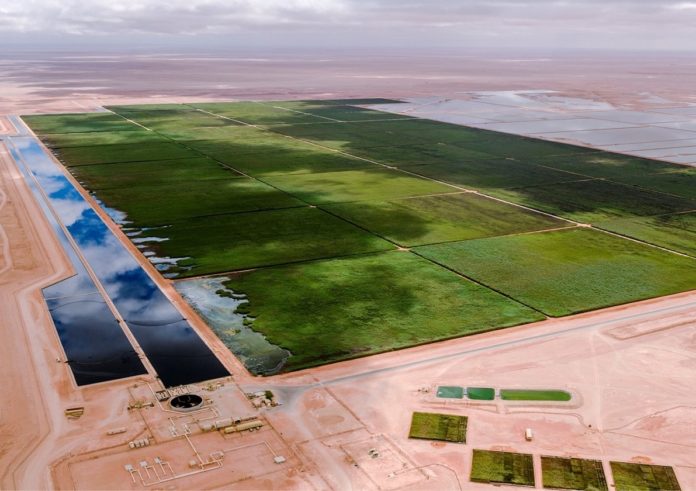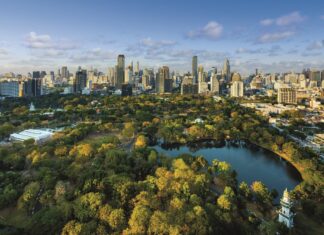A third phase is just being completed at the Nimr Water Treatment Plant in Oman, expanding what is already the largest industrial constructed wetland facility in the world.
The plant provides an alternative solution to the issue of produced water management from the Nimr oilfields in the southern Oman desert. Widely acknowledged as one of the most innovative environmentally friendly treatment plants in the international oil and gas sector, the latest phase will increase its treatment capacity by 50%.
The Nimr Water Treatment Plant (NWTP) is designed, built, owned and operated by the German company Bauer Resources GmbH and its subsidiary in Oman, Bauer Nimr LLC. The latest phase is taking the treatment capacity to 175,000 m³/day, and is adding 1.2 million m² of constructed wetlands to the existing 3.6 million m². The current plant also features a series of evaporation ponds with a total area of 5 million m², fed by the treated effluent, free of oil hydrocarbons, resulting in salt formation, which can be processed into industrial grade salt as an end product.
Produced water
Produced water is the oily wastewater generated in large volumes during the extraction and recovery of oil. The traditional disposal method in Oman, and in many oil-producing countries, is re-injection into aquifers through deep wells. This is energy intensive, has high operation and maintenance costs, and risks aquifer contamination. Various mechanical / chemical handling methods have been developed, but often have high operational and maintenance costs.
Expansion phases
The first phase of this unique project was commissioned in late 2010 and was initially designed to treat 45,000 m³/day of produced water. Oil-in-water content is the target pollutant, with an average inlet concentration of 350 ppm and spikes in excess of 500 ppm. Produced water from the oil field is brackish, with inlet total dissolved solids between 7-8,000 mg/l.
The NWTP facility includes an upstream oil-in-water separation stage using passive hydrocyclone units, where more than 90% of the oil content is recovered without any energy input or chemical use. The water then flows by gravity through a long distribution pond to a series of surface flow constructed wetland basins, in the first phase covering 2.5 million m². Here the residual oil content is degraded naturally by microbial processes. The constructed wetland system is built in a previously arid desert and is designed to meet the strict effluent limit value of 0.5 ppm according to the Oman National Standards.
A second phase was completed in January 2015, increasing the treatment capacity to 115,000 m³/day (or more than 690,000 barrels/day), with the constructed wetlands covering an area equivalent to 640 football pitches.
Environmental performance
The NWTP has been instrumental in reducing the amount of produced water that is disposed to the deep well aquifers. The facility is gravity-based, with close to zero energy demand for the water treatment processes and minimal fossil fuel consumption for its operation. This translates into enormous cost and resources savings and significant greenhouse gas emissions reduction (>99%) compared to pumping into deep aquifers.
The result of this project is a significant reduction in the Nimr oilfield’s environmental footprint, and the NWTP alone contributes around 4.3% to Oman’s overall Intended Nationally Determined Contributions to reduce greenhouse gas emissions by 2%.
The constructed wetlands are planted with five native reed species, enhancing resilience and biodiversity. The combined system of the wetlands and ponds created a new valuable habitat in the desert, attracting thousands of migratory birds.
The main focus of current sustainability efforts is on reuse of the brackish treated effluent. A large experimental field of 220,000 m² has been created, to test irrigation of various salt tolerant plants with valuable commercial end-products. Ultimately, the whole effluent volume will be reused for biosaline irrigation. Additionally, a first successful composting trial has been carried out using wetlands reed biomass.
The technical and environmental performance of this facility has made it a landmark for the oil and gas sector and the wider environmental community, and the project as received numerous awards.
The solution can be adapted both to warm, dry regions and to colder climates. Space requirements limit the application range, but this is counterbalanced by the significant energy savings and sustainable nature of the approach.
Dr Alexandros Stefanakis, constructed wetlands specialist – tender manager, Bauer Nimr LLC, Sultanate of Oman, and Bauer Resources GmbH, Germany





